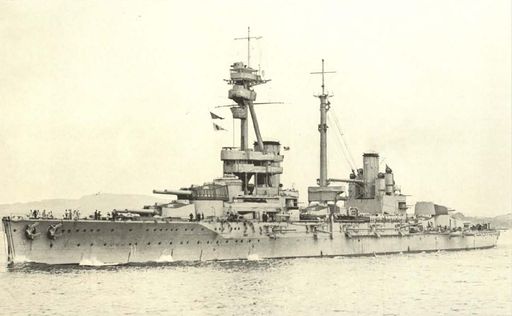H.M.S. Agincourt (1913)
| H.M.S. Agincourt | |
| Career | Details |
|---|---|
| Pennant: | 09 (April, 1918)[1] |
| Built By: | Armstrong's, Elswick |
| Laid down: | 14 September, 1911 |
| Launched: | 22 January, 1913 |
| Commissioned: | 7 August, 1914 |
| Sold: | 19 December, 1922 |
| Fate: | Scrapped |
Officially job 690A.
Launch
Rio de Janeiro was launched on 22 January, 1913 by Mme. Huet de Bacellar, wife of Admiral Huet de Bacellar, the Chief of the Brazilian Naval Commission. The Brazilian Minister was represented by Senhor A. Guerre Duval.
Seizure
On 31 July, 1914, Churchill wrote to the King that:
- I have taken the responsibility of forbidding the departure of the Turkish battleship Osman (late Rio) with the Prime Minister's approval. If war comes she will be called - and shd Your Majesty approve - the Agincourt & will convey Sir Henry Jackson to reinforce, & at the regular date assume command of, the Mediterranean.[2]
Alterations

Although in November, 1914 Agincourt was specified as a ship to receive a director and this task received special emphasis in mid 1915,[3] she fought at the Battle of Jutland without a director[4] and was not fitted until some time in June-July, 1916 while at Portsmouth Royal Dockyard.[Citation needed]
As of February, 1916, Agincourt had not yet been fitted with a Dreyer Fire Control Table.[5] It is therefore possible that she was not so fitted at the Battle of Jutland,[6] but it as yet unconfirmed. As of June, 1918, she had been fitted with a Mark I fire control table.[7]
At some point, Agincourt was equipped with two Mechanical Aid-to-Spotter Mark Is, one on each side of the foretop, keyed off the Evershed rack on the director. As the need for such gear was apparently first identified in early 1916, it seems likely that these installations were effected well after Jutland.[8]
Agincourt received directors for her secondary battery in July, 1918.[9]
Rangefinders
In 1918, it was proposed that she should add a 9-foot rangefinder for torpedo control low down before the fore mast on the navigating bridge, although the then-existing 9-foot instrument in the lower top for the 6-inch guns had been offered as available for torpedo control if desired since 1915.[10]
Captains
Dates of appointment given:
- Captain Douglas R. L. Nicholson, 7 August, 1914.[11]
- Captain Henry M. Doughty, 10 January, 1916.[12]
- Captain Henry L. Mawbey, 11 April, 1917.[13]
Jutland
See Also
Footnotes
- ↑ Dittmar; Colledge. British Warships 1914–1919
- ↑ Winston S. Churchill. Companion Volume II Part 3. p. 1992.
- ↑ The Technical History and Index: Fire Control in H.M. Ships. p. 10.
- ↑ The Technical History and Index: Fire Control in H.M. Ships. p. 11.
- ↑ Schliehauf. The Dumaresq and the Dreyer Part II. pp. 186, 201, citing The National Archives. T 173/204.
- ↑ Friedman. p. 46.
- ↑ Handbook of Captain F. C. Dreyer's Fire Control Tables. p. 3.
- ↑ The Technical History and Index: Fire Control in H.M. Ships, 1919. pp. 25-6.
- ↑ The Technical History and Index: Fire Control in H.M. Ships. p. 16.
- ↑ Annual Report of the Torpedo School, 1918. p. 178. (G. 8256/15)
- ↑ Navy List (December, 1914). p. 270.
- ↑ Navy List (December, 1916). p. 391d.
- ↑ Navy List (October, 1917). p. 391d.
Bibliography
- Dittmar, F.J.; Colledge, J.J. (1972). British Warships 1914–1919. London: Ian Allan.
- Template:BibUKFireControlInHMShips1919
- Template:BibParkesBritishBattleships